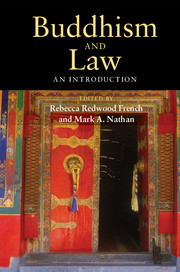Book contents
- Frontmatter
- Dedication
- Contents
- Maps and Illustrations
- Contributors
- Preface
- Abbreviations
- Introducing Buddhism and Law
- Part I The Roots of Buddhism and Law in India
- 1 Society at the Time of the Buddha
- 2 What the Vinayas Can Tell Us about Law
- 3 Keeping the Buddha’s Rules
- 4 Proper Possessions
- 5 On the Legal and Economic Activities of Buddhist Nuns
- Part II Buddhism and Law in South and Southeast Asia
- Part III Buddhism and Law in East Asia
- Part IV Buddhism and Law in North Asia and the Himalayan Region
- A Selection of Readings
- Index
- References
2 - What the Vinayas Can Tell Us about Law
Published online by Cambridge University Press: 05 August 2014
- Frontmatter
- Dedication
- Contents
- Maps and Illustrations
- Contributors
- Preface
- Abbreviations
- Introducing Buddhism and Law
- Part I The Roots of Buddhism and Law in India
- 1 Society at the Time of the Buddha
- 2 What the Vinayas Can Tell Us about Law
- 3 Keeping the Buddha’s Rules
- 4 Proper Possessions
- 5 On the Legal and Economic Activities of Buddhist Nuns
- Part II Buddhism and Law in South and Southeast Asia
- Part III Buddhism and Law in East Asia
- Part IV Buddhism and Law in North Asia and the Himalayan Region
- A Selection of Readings
- Index
- References
Summary
“Whatever Dhamma and Vinaya has been taught, made known by me to you, Ānanda, will, with my passing, be your Teacher.”
Introduction
When the Buddha entered Nirvāṇa, he is said to have left his adherents with what he had taught, that is, with dharma (Pāli dhamma) and Vinaya. No central body headed the Buddhist community. As the highest legal authority, the Buddhist monastic legal code, Vinaya, served as a guide for the daily life of monastics of the Buddhist community (saṅgha): Buddhist monks and nuns and, to a lesser degree, male and female novices as well as female probationers. The Vinaya forms the first part of the Buddhist canon, the so-called tripiṭaka – the authoritative Buddhist writings believed to be the “Word of the Buddha.” It contains the rules and regulations that govern the life of monastics both as individuals and as a community. Unlike the discourses, sūtra, which are directed toward lay people and ordained alike, the Vinaya is an internal document meant for monastics. Since the community of the Buddhists split into two branches – Mahāsāṃghikas and Sthaviravādins, which subsequently split into further schools, all transmitting the word of the Buddha – we have not one, but several canons and, consequently, several Vinayas. The Vinayas are not systematically planned and arranged law books. Rather, they are based on case law. They constitute one of the oldest self-contained legal systems, of which the Buddha is thought to be the lawgiver. Unlike the primarily prescriptive Brahmanical law codes, the Vinayas contain narrative portions, commentaries, and casuistries, albeit to different degrees. These additional portions shed some light on the historical realities of the religious communities in which they were authored and subsequently redacted.
- Type
- Chapter
- Information
- Buddhism and LawAn Introduction, pp. 46 - 62Publisher: Cambridge University PressPrint publication year: 2014
References
- 4
- Cited by



